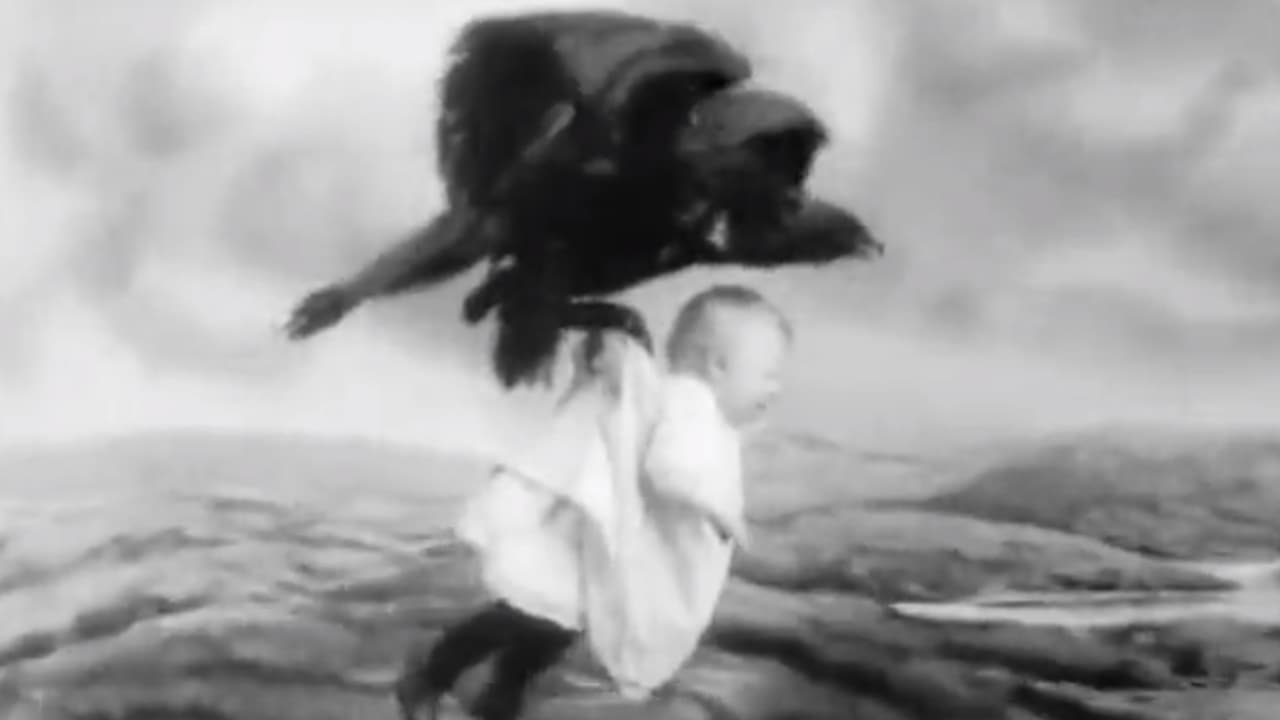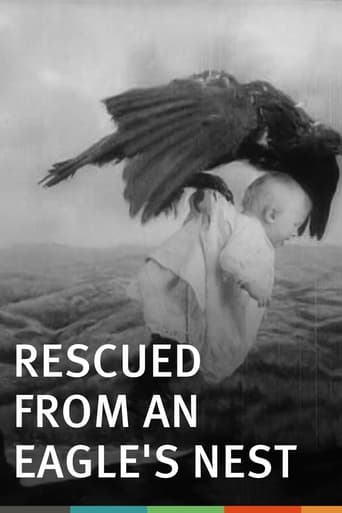Smartorhypo
Highly Overrated But Still Good
Onlinewsma
Absolutely Brilliant!
Quiet Muffin
This movie tries so hard to be funny, yet it falls flat every time. Just another example of recycled ideas repackaged with women in an attempt to appeal to a certain audience.
Noelle
The movie is surprisingly subdued in its pacing, its characterizations, and its go-for-broke sensibilities.
JoeytheBrit
I guess the most convincing performance in this early silent drama comes from the baby as it is carried through the air by an eagle. The poor little ankle-biter screams his (or her) lungs out as we see him flying across a dodgy background while in the eagle's clutches. Really gets into the part, she (or he) does. Most everything else about the film is average at best, but at least the plot is easy to follow. Films were still too early for leading men or women to stamp their personality on a role, so it's not really possible to pass an opinion on the performance of D. W. Griffith and his fellow actors, other than to say they are no better or worse than others of the time. The special effects are pretty second rate - even for 1908 - but director J. Searle Darley demonstrates a sound grasp of the techniques that were then available to him.
wes-connors
D.W. Griffith gets his ax, kisses his wife, and tweaks his baby; then, Woodsman Griffith is off to work. While he's chopping down trees, a huge Eagle swoops down and kidnaps his unattended baby. Mother emerges and discovers the Eagle has taken her child; she picks up a rifle, but, wisely, thinks before shooting at the airborne pair. Instead, she goes to get Griffith and his fellow woodsmen, who must see that the baby is "Rescued from an Eagle's Nest".Notable for its star, Lawrence Griffith, who would soon begin unprecedented success as film Director D.W. Griffith. The "special effects" look very phony - and, that baby has incredibly odd looking feet, while in flight! Griffith's final battle with the Eagle is mildly interesting, but there isn't much else here. It might have been a fair film if Edison and company had the bird nesting in a tree cut, or likely to be chopped down, by the woodsmen. Or, they could have made the bird a Vulture… ** Rescued from an Eagle's Nest (1/16/08) J. Searle Dawley ~ D.W. Griffith, Henry B. Walthall, Miss Earle
José Luis Rivera Mendoza (jluis1984)
In 1908, a 34 year old playwright named D.W. Griffith was having little success with his plays and decided to try his luck in the newly formed movie industry with an adaptation of "Tosca" he intended to sell to the film studios of the Edison Manufacturing Company. The head of the studio at the time was film pioneer Edwin S. Porter, who wasn't really impressed with Griffith's work as a writer but, since Griffith was also an actor, Porter decided to hire him and send him to director J. Searle Dawley. A former theater director (he liked to called himself as "the first professional motion picture director"), Dawley immediately chose Griffith for the main role in his new film: "Rescued from an Eagle's Nest". It would be in this early adventure film where D.W. Griffith would have his first contact with the movie industry and where he would first learn the crafts that would make him a legendary filmmaker in the following years."Rescued from an Eagle's Nest" is the story of a woodsman's family and the extraordinary adventure they live one day while the Father (D.W. Griffith) was outside working. After the father leaves the house, the Mother (Miss Earle) begins her own housework and leaves the child (Jinnie Frazer) outside to play. While the mother is inside the cabin, a big eagle descends from the sky and takes the child away. The mother notices the eagle kidnapping the kid, but it's too late for her to save him, so she runs to the woods in order to tell her husband about it. After hearing what has happened to his child, the lumberjack and his mates run together to the mountains. When they find the nest, they discover that it's very difficult to reach it, so the Woodsman takes a rope with him and begins to climb down. However, before returning home he'll have to face the eagle that kidnapped his kid.As usual with the early movies from the Edison Manufacturing Company, it can't be known for sure who exactly wrote the screenplay of the film, but considering director J. Searle Dawley's background, it is highly probable that it was all Dawley's creation expanding from one of his or Porter's ideas. The story of "Rescued from an Eagle's Nest" is pretty simple and has almost no characterization, focusing on the action and adventure that the Woodsman faces to save his kid. In this sense, the movie works like a folktale put on film, as it is concerned more about the adventure in itself than about the characters. While simple in its construction, the plot of "Rescued from an Eagle's Nest" remains so universal that is hard not to feel thrilled by the Woodsman's adventure.In "Rescued from an Eagle's Nest", director J. Searle Dawley truly shows a better understanding of the new options that film offered him as a narrative language, and moves further away from the idea that movies were simply plays on film. The influence of Edwin S. Porter (who was in charge of cinematography in this movie) can be seen in many scenes as Dawley employs several of the editing techniques that Porter originated in his 1903 seminal classic, "Life of an American Fireman" (Techniques that Griffith would further develop in his own films). This is reflected in the very original ways the movie uses edition and its primitive special effects to play with action and suspense in order to thrill and surprise the audience. By our standards, the effects look poor and clichéd, but it was definitely a step ahead in its time.As written above, the film focuses entirely on the family's adventure without leaving too much for character development, so it would be not only difficult but also unfair to judge the performances of the cast on those terms. So considering that they were playing basically archetypes, it could be said that the whole cast was actually good, as there rarely was any overacting (so common in the early days of cinema) and everyone seemed to know what to do. It is obviously interesting to see D.W. Griffith as the Woodsman, and his performance doesn't disappoint. His fight with the eagle is a very good scene that forecasts similar scenes in future action movies like the ones with Douglas Fairbanks. Even when she was not a professional actress (or probably because of that very reason), Miss Earle is very good and looks very natural in her concern for her baby.While the film still feels stagy at times, it was a step ahead in the development of the language of cinema that spawned an entire series of imitators that further developed the adventure genre (even Griffith himself would use the same basic plot of a kidnapped child in his first movie, "The Adventures of Dollie"). To call this movie clumsy or uneven and judge it under our standards is criminally unfair, as while "Rescued from an Eagle's Nest" is not a perfect movie, it is not only actually very good for its time but it also helped to set the basis for the action and adventure films of today. "Rescued from an Eagle's Nest" is not only a must see for Griffith fans interested on his first work, it is also an amusing short movie for fans of early action movies and silent film in general. 7/10
Snow Leopard
In terms of quality, this is a pretty uneven feature, but it is certainly interesting. The story creates some good suspense, and although it seems pretty far-fetched, it was said to have been based, at least in part, on an actual incident. Some significant parts of the story rely heavily on special effects that do not hold up very well by later standards, yet they do tell the story clearly.This movie might be best known now for the very early screen appearance of D.W. Griffith, as the father whose child is carried away by the eagle. His performance is at least adequate for its time, as are those of the rest of the cast.The movie uses several sequences of visual effects to depict the eagle's capture of the child, and its subsequent conflict with Griffith. As was often the case in movies by Edwin S. Porter and other Edison film-makers, the emphasis is on making it clear what is happening, rather than on striving for a completely seamless or convincing effect. This makes the special effects look very unconvincing now, but to their original audience, they probably looked a lot better.This seems to have been a pretty ambitious effort for its day, and even if it does not look very impressive now, it has enough interesting aspects to be worth watching.

